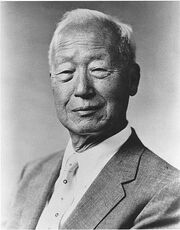
Syngman Rhee in 1956
RHEE, Syngman (Korean: 이승만 I Seungman, pronounced [iː sʰɯŋ.man]; April 18, 1875 – July 19, 1965) was a Korean statesman and the first president of the Provisional Government of the Republic of Korea as well as the first president of South Korea. His three-term presidency of South Korea (August 1948 to April 1960) was strongly affected by Cold War tensions on the Korean peninsula.
Rhee was regarded as an anti-Communist and he led South Korea through the Korean War. His presidency ended in resignation following popular protests against a disputed election. He died in exile in Honolulu, Hawaii.
Taekwondo[]
Near the end of the Korean War in 1952, Rhee witnessed a pivotal martial arts demonstration:
- "By 1954, they (General Choi Hong Hi and Nam Te Hi) were confident enough in their fifty martial artists from the 29th Division that they organized a demonstration for South Korea's president, Syngman Ree. Choi wanted to show Rhee that the 29th Division contained great soldiers.
- "Nam would never forget the day of the demonstration, which took place on the grass of an outdoor stadium, part of an anniversary celebration for the First Army Corps. President Rhee watched from an elevated platform, along with anyone else who mattered in Korea's military. Thousands of soldiers watched Nam and his soldiers complete patterns, self-defence, bayonet-defence, and sparring. When Nam's team finished, President Rhee remained standing, wishing them to continue. He must have known about Nam's hand-to-hand battle on Yongmun Mountain in the Korean War, because he had awarded special honours to Nam's division.
- "Nam and his assistant, Han Cha-gyo, had been given only fifteen minutes for a demonstration, so they improvised from what they knew during the extra time, exploding in a series of knife-hands and other techniques in a pattern called Hwa-Rang that Nam had created from a Korean Karate pattern. Nam also defended against an attack by two men, then three. At one point, he walked up to a pile of thirteen clay roof tiles, each of which was three-quarters of an inch thick. Someone with no martial arts training would have found it difficult to break two tiles, and these thirteen protruded from the ground more than a foot. Nam exuded power, but he was not a tall man, so as he stood over the tiles and raised his hand, the soldiers must have wondered if breaking them would be possible.
- "Nam smashed the curved tiles with a single downward punch.
- "The president was amazed. 'What was on his hand?' he asked General Choi.
- "'Nothing,' Choi replied. 'He broke them with his fist, his bare hand.' 'Is this the part he used?' the president asked, pointing to his first two knuckles.
- "'Yes, sir,' Choi replied." - Gillis, Alex. A Killing Art: The Untold History of Tae Kwon Do.
Rhee was sufficiently impressed that he directed that martial arts training become an integral aspect of military life. He requested, however, that the kwans come together to establish a single Korean martial art for this purpose. In 1955 a meeting was convened to decide upon a single name for the newly integrated Korean martial art. At that time no decision could be reached. Finally in 1957 the name taekwondo was suggested. The name resonated with those who felt that it harkened back to the similar-sounding, ancient tae kyon tradition. Eventually, the name taekwondo was adopted into common usage.
References[]
- Syngman Rhee on Wikipedia
- Sygnman Rhee on the Korean version of Wikipedia http://ko.wikipedia.org/wiki/이승만 (use Chrome browser or Google Translate to read in English)